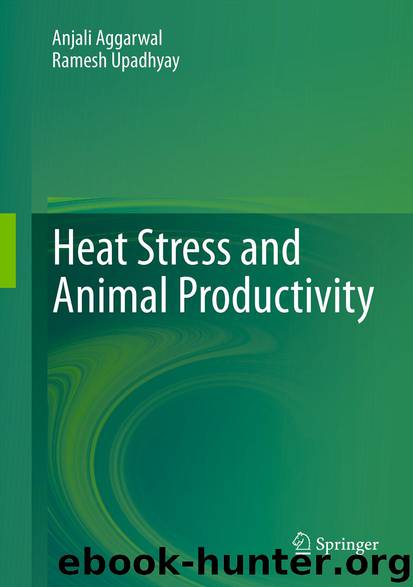Heat Stress and Animal Productivity by Anjali Aggarwal & Ramesh Upadhyay

Author:Anjali Aggarwal & Ramesh Upadhyay
Language: eng
Format: epub
Publisher: Springer India, India
Physical Characteristics of Semen
The quantity and quality of semen vary with seasons, although the degrees of response to seasonal effects vary according to species, breed and locality. Season affects ejaculate volume; however, information on influences of high environmental temperature on semen–ejaculate volume is conflicting. The studies of Zeidan (1989) and Marai et al. (1996) showed that semen–ejaculate volume decreased, while studies of Fawzy (1982) showed remarkable increase with heat elevation. The highest mean value (3.7 ± 0.1 ml) was recorded in winter and the lowest (2.4 ± 0.1 ml) in spring. Mean values of 2.9 ± 0.2 and 2.6 ± 0.l ml were recorded in summer and autumn, respectively. The effects of season on motility of spermatozoa are inconclusive and conflicting. The initial motility of spermatozoa has been observed to decrease in hot climate conditions (Ax et al. 1989; Zeidan 1989). Other studies indicated that motility of spermatozoa either increased (Oloufa et al. 1959; El-Azab 1980) or did not show any change due to season of the year or elevation of temperature (Zeidan 1989; Silvia et al. 1991).
Zeidan (1989) observed that live sperm were 87.5 ± 0.5, 76.2 ± 0.8, 74.5 ± 1.5 and 85.8 ± 0.6% during spring, summer, autumn and winter, respectively. Everett et al. (1978) recorded the highest total sperm output during summer season. Spring and summer seasons were characterised by the highest percentage of ejaculates with white milky (47.4%) and opaque creamy (28.5%) appearance and by the lowest percentage with greyish soapy (14%) and translucent watery (10%) appearance. In contrary, autumn showed the highest percentage of bad semen appearance. In other words, the highest percentage (47.4%) of ejaculates showed a white milky appearance, whereas (28.5%) was opaque creamy, 14% greyish soapy and 10% translucent white watery. Generally, semen appearance varied from opaque creamy to translucent watery. The difference in the results may be due to type and duration of heat exposure, intensity of environmental heat and differences in species, breed and age of the experimental animals.
Murrah buffalo bulls subjected to surface cooling had good quality (creamy and light creamy) semen more frequently with high sperm concentration, mass activity, motility % and live sperm production in cooled than uncooled cows but had no effect on semen volume and pH (Mandal et al. 2002).
Download
This site does not store any files on its server. We only index and link to content provided by other sites. Please contact the content providers to delete copyright contents if any and email us, we'll remove relevant links or contents immediately.
| Automotive | Engineering |
| Transportation |
Whiskies Galore by Ian Buxton(41879)
Introduction to Aircraft Design (Cambridge Aerospace Series) by John P. Fielding(33064)
Small Unmanned Fixed-wing Aircraft Design by Andrew J. Keane Andras Sobester James P. Scanlan & András Sóbester & James P. Scanlan(32743)
Craft Beer for the Homebrewer by Michael Agnew(18140)
Turbulence by E. J. Noyes(7936)
The Complete Stick Figure Physics Tutorials by Allen Sarah(7307)
Kaplan MCAT General Chemistry Review by Kaplan(6867)
The Thirst by Nesbo Jo(6828)
Bad Blood by John Carreyrou(6552)
Modelling of Convective Heat and Mass Transfer in Rotating Flows by Igor V. Shevchuk(6391)
Learning SQL by Alan Beaulieu(6211)
Weapons of Math Destruction by Cathy O'Neil(6146)
Man-made Catastrophes and Risk Information Concealment by Dmitry Chernov & Didier Sornette(5921)
Digital Minimalism by Cal Newport;(5664)
Life 3.0: Being Human in the Age of Artificial Intelligence by Tegmark Max(5474)
iGen by Jean M. Twenge(5366)
Secrets of Antigravity Propulsion: Tesla, UFOs, and Classified Aerospace Technology by Ph.D. Paul A. Laviolette(5309)
Design of Trajectory Optimization Approach for Space Maneuver Vehicle Skip Entry Problems by Runqi Chai & Al Savvaris & Antonios Tsourdos & Senchun Chai(5011)
Pale Blue Dot by Carl Sagan(4912)
